Sustainability Assessment of Traditional Agroecosystems in the High Region of Yaonáhuac, Puebla, Mexico
Abstract
:1. Introduction
Home Gardens and Sustainability
2. Materials and Methods
2.1. Study Region
2.2. Data Gathering
2.3. Index Construction
3. Results and Discussion
3.1. Diversity-Resilience
3.2. Self-Management-Autonomy
3.3. Integration
3.4. Self-Sufficiency
3.5. Sustainability of Nahua Home Gardens in the High Region of Yaonáhuac, Puebla
3.5.1. Home Gardens with Intermediate Sustainability
3.5.2. Home Gardens with Strong Sustainability
3.5.3. Home Gardens with Super Strong Sustainability
4. Conclusions
Author Contributions
Funding
Institutional Review Board Statement
Informed Consent Statement
Acknowledgments
Conflicts of Interest
References
- Altieri, M.A. Agroecology: The science of natural resource management for poor farmers in marginal environments. Agric. Ecosyst. Environ. 2002, 93, 1–24. [Google Scholar] [CrossRef]
- Fish, R.; Church, A.; Winter, M. Conceptualising cultural ecosystem services: A novel framework for research and critical engagement. Ecosyst. Serv. 2016, 21, 208–217. [Google Scholar] [CrossRef] [Green Version]
- Sabiha, N.-E.; Salim, R.; Rahman, S.; Rola-Rubzen, M.F. Measuring environmental sustainability in agriculture: A composite environmental impact index approach. J. Environ. Manag. 2016, 166, 84–93. [Google Scholar] [CrossRef] [PubMed] [Green Version]
- Altieri, M.A.; Koohafkan, P. Enduring Farms: Climate Change, Smallholders and Traditional Farming Communites [Internet]; Third World Network: Penang, Malasya, 2008; pp. 1–72. Available online: http://www.fao.org/nr/water/docs/enduring_farms.pdf (accessed on 15 October 2020).
- Koohafkan, P.; Altieri, M.A. Sistemas Ingeniosos del Patrimonio Agrícola Mundial: Un Legado Para el Futuro; SIPAM; FAO: Roma, Italy, 2011; p. 47. [Google Scholar]
- Altieri, M.A.; Funes-Monzote, F.R.; Petersen, P. Agroecologically efficient agricultural systems for smallholder farmers: Contributions to food sovereignty. Agron. Sustain. Dev. 2012, 32, 1–13. [Google Scholar] [CrossRef] [Green Version]
- Altieri, M.A.; Toledo, V.M. The agroecological revolution in Latin America: Rescuing nature, ensuring food sovereignty and empowering peasants. J. Peasant. Stud. 2011, 38, 587–612. [Google Scholar] [CrossRef]
- Fernandez, M.; Goodall, K.; Olson, M.; Méndez, V.E. Agroecology and alternative agri-food movements in the United States: To-ward a sustainable agri-food system. Agroecol. Sustain. Food Syst. 2013, 37, 115–126. [Google Scholar]
- Nicholls, C.; Altieri, M.; Vazquez, L. Agroecology: Principles for the Conversion and Redesign of Farming Systems. J. Ecosyst. Ecography 2016, 5, 1–18. [Google Scholar]
- Reyna-Ramírez, C.A.; Rodríguez-Sánchez, L.M.; Vela-Correa, G.; Etchevers-Barra, J.; Fuentes-Ponce, M. Redesign of the traditional Mesoamerican agroecosystem based on participative ecological intensification: Evaluation of the soil and efficiency of the system. Agric. Syst. 2018, 165, 177–186. [Google Scholar] [CrossRef]
- Tittonell, P. Assessing resilience and adaptability in agroecological transitions. Agric. Syst. 2020, 184, 102862. [Google Scholar] [CrossRef]
- Toledo, V.M.; Moguel, P. Coffee and Sustainability: The Multiple Values of Traditional Shaded Coffee. J. Sustain. Agric. 2012, 36, 353–377. [Google Scholar] [CrossRef]
- Speelman, E.N.; López-Ridaura, S.; Colomer, N.A.; Astier, M.; Masera, O.R. Ten years of sustainability evaluation using the MESMIS framework: Lessons learned from its application in 28 Latin American case studies. Int. J. Sustain. Dev. World Ecol. 2007, 14, 345–361. [Google Scholar] [CrossRef]
- Astier, M.; Speelman, E.N.; López-Ridaura, S.; Masera, O.R.; Gonzalez-Esquivel, C.E. Sustainability indicators, alternative strategies and trade-offs in peasant agroecosystems: Analysing 15 case studies from Latin America. Int. J. Agric. Sustain. 2011, 9, 409–422. [Google Scholar] [CrossRef]
- Peano, C.; Tecco, N.; Dansero, E.; Girgenti, V.; Sottile, F. Evaluating the sustainability in complex agri-food systems: The SAE-METH ramework. Sustainability 2015, 7, 6721–6741. [Google Scholar] [CrossRef] [Green Version]
- Flores, C.C.; Sarandón, S.J. Limitations of Neoclassical Economics for Evaluating Sustainability of Agricultural Systems: Com-paring Organic and Conventional Systems. J. Sustain. Agric. 2004, 24, 77–91. [Google Scholar] [CrossRef]
- Boege, E. El Patrimonio Biocultural de los Pueblos Indígenas de México. Hacía la Conservación In Situ de la Biodiversidad y Agrodiversidad en los Territorios Indígenas, Primera ed.; Chan, G.V., Coll, I.G., Mondragón, M., Rivas, A., Lozada, M.P., Soto, F., Eds.; Instituto Nacional de Antropologóa e Historia: Ciudad de México, Mexico; Comisión Nacional para el Desarrollo de los Pueblos Indígenas: Mexico City, Mexico, 2008; p. 344. [Google Scholar]
- Bermeo, A.; Couturier, S.; Pizaña, M.G. Conservation of traditional smallholder cultivation systems in indigenous territories: Mapping land availability for milpa cultivation in the Huasteca Poblana, Mexico. Appl. Geogr. 2014, 53, 299–310. [Google Scholar] [CrossRef]
- Toledo, V.M.; Barrera-Bassols, N. Political Agroecology in Mexico: A Path toward Sustainability. Sustainability 2017, 9, 268. [Google Scholar] [CrossRef] [Green Version]
- Toledo, V.M.; Ortiz-Espejel, B.F.; Cortés, L.; Moguel, P.; Ordoñez, M.D.J. The Multiple Use of Tropical Forests by Indigenous Peoples in Mexico: A Case of Adaptive Management. Conserv. Ecol. 2003, 7. [Google Scholar] [CrossRef] [Green Version]
- Darnhofer, I.; Fairweather, J.; Moller, H. Assessing a farm’s sustainability: Insights from resilience thinking. Int. J. Agric. Sustain. 2010, 8, 186–198. [Google Scholar] [CrossRef]
- Boege, E. Hacia una antropología ambiental para la apropiación social del patrimonio biocultural de los pueblos indígenas en América Latina. Desenvolv. Meio Ambient. 2015, 35, 101–120. [Google Scholar] [CrossRef] [Green Version]
- Vidal, O.; Brusca, R.C. Mexico’s biocultural diversity in peril. Rev. Biol. Trop. 2020, 68, 669–691. [Google Scholar] [CrossRef]
- Altieri, M.A.; Nicholls, C.I. Agroecology: A brief account of its origins and currents of thought in Latin America. Agroecol. Sustain. Food Syst. 2017, 41, 231–237. [Google Scholar] [CrossRef]
- Lappé, F.M. Farming for a Small Planet: Agroecology Now. Development 2016, 59, 299–307. [Google Scholar] [CrossRef]
- Rankoana, S.A. Subsistence Food Production Practices: An Approach to Food Security and Good Health. Int. J. Environ. Res. Public Health 2017, 14, 1184. [Google Scholar] [CrossRef] [PubMed] [Green Version]
- Singh, R.K.; Kumar, A.; Singh, A.; Singhal, P. Evidence that cultural food practices of Adi women in Arunachal Pradesh, India, improve social-ecological resilience: Insights for Sustainable Development Goals. Ecol. Process. 2020, 9, 1–19. [Google Scholar] [CrossRef]
- Zhang, Y.; Yang, L.-X.; Li, M.-X.; Guo, Y.-J.; Li, S.; Wang, Y.-H. The best choices: The diversity and functions of the plants in the home gardens of the Tsang-la (Motuo Menba) communities in Yarlung Tsangpo Grand Canyon, Southwest China. J. Ethnobiol. Ethnomed. 2020, 16, 1–15. [Google Scholar] [CrossRef]
- Avilez-López, T.; Van Der Wal, H.; Aldasoro-Maya, E.M.; Rodríguez-Robles, U. Home gardens’ agrobiodiversity and owners’ knowledge of their ecological, economic and socio-cultural multifunctionality: A case study in the lowlands of Tabasco, México. J. Ethnobiol. Ethnomed. 2020, 16, 1–13. [Google Scholar] [CrossRef]
- La Vía Campesina. Sustainable Peasant and Family Farm Can Feed the World. Via Campesina Views [Internet]. 2010. Available online: https://viacampesina.org/downloads/pdf/en/paper6-EN-FINAL.pdf (accessed on 14 October 2020).
- Altieri, M.A.; Nicholls, C.I.; Henao, A.; Lana, M.A. Agroecology and the design of climate change-resilient farming systems. Agron. Sustain. Dev. 2015, 35, 869–890. [Google Scholar] [CrossRef] [Green Version]
- Groot, J.C.J.; Cortez-Arriola, J.; Rossing, W.A.H.; Massiotti, R.D.A.; Tittonell, P. Capturing Agroecosystem Vulnerability and Resilience. Sustainability 2016, 8, 1206. [Google Scholar] [CrossRef] [Green Version]
- Marten, G. Productivity, Stability, Sustainability, Equitability and Autonomy as Properties for Agroecosystem Assessment. Agric. Syst. 1988, 26, 291–316. Available online: http://www.gerrymarten.com/publicatons/agroecosystem-Assessment.html (accessed on 7 February 2017). [CrossRef] [Green Version]
- Šūmane, S.; Kunda, I.; Knickel, K.; Strauss, A.; Tisenkopfs, T.; des los Rios, I.; Rivera, M.; Chebach, T.; Ashkenazy, A. Local and farmers’ knowledge matters! How inte-grating informal and formal knowledge enhances sustainable and resilient agriculture. J. Rural Stud. 2018, 59, 232–241. [Google Scholar] [CrossRef]
- Anderson, C.R.; Bruil, J.; Chappell, M.J.; Kiss, C.; Pimbert, M.P. From Transition to Domains of Transformation: Getting to Sustaina-ble and Just Food Systems through Agroecology. Sustainability 2019, 11, 5272. [Google Scholar] [CrossRef] [Green Version]
- Barrera-Bassols, N.; Toledo, V.M. Ethnoecology of the Yucatec Maya: Symbolism, knowledge and management of natural re-sources. J. Lat. Am. Geogr. 2005, 4, 9–41. [Google Scholar] [CrossRef]
- Toledo, V.M. Indigenous Peoples and Biodiversity. Encycl. Biodivers. 2013, 4, 269–278. [Google Scholar]
- De Roest, K.; Ferrari, P.; Knickel, K. Specialisation and economies of scale or diversification and economies of scope? Assessing different agricultural development pathways. J. Rural Stud. 2018, 59, 222–231. [Google Scholar] [CrossRef]
- Shmelev, S.E.; Rodríguez-Labajos, B. Dynamic multidimensional assessment of sustainability at the macro level: The case of Austria. Ecol. Econ. 2009, 68, 2560–2573. [Google Scholar] [CrossRef]
- Gudynas, E. Desarrollo y sustentabilidad ambiental: Diversidad de posturas, tensiones persistentes. In La Tierra no es Muda: Diálogos Entre el Desarrollo Sostenible y el Postdesarrollo; Matarán Ruíz, A., López Castellano, F., Eds.; Universidad de Granada: Granada, Spain, 2011; pp. 69–96. [Google Scholar]
- Cinelli, M.; Coles, S.R.; Kirwan, K. Analysis of the potentials of multi criteria decision analysis methods to conduct sustainability assessment. Ecol. Indic. 2014, 46, 138–148. [Google Scholar] [CrossRef] [Green Version]
- Chan, K.M.A.; Balvanera, P.; Benessaiah, K.; Chapman, M.; Díaz, S.; Gómez-Baggethun, E.; Gould, R.; Hannahs, N.; Jax, K.; Klain, S.; et al. Opinion: Why protect nature? Rethinking values and the environment. Proc. Natl. Acad. Sci. USA 2016, 113, 1462–1465. [Google Scholar] [CrossRef] [Green Version]
- Cooper, N.; Brady, E.; Steen, H.; Bryce, R. Aesthetic and spiritual values of ecosystems: Recognising the ontological and axiological plurality of cultural ecosystem ‘services’. Ecosyst. Serv. 2016, 21, 218–229. [Google Scholar] [CrossRef] [Green Version]
- Barmashova, T.I.; Lazutkina, E.V. Bioethics as effective method for preserving biological diversity on Earth. IOP Conf. Ser. Earth Environ. Sci. 2020, 548, 072050. [Google Scholar] [CrossRef]
- INEGI. Anuario Estadístico y Geográfico de Puebla 2017; INEGI: Puebla, Mexico, 2017; p. 940. [Google Scholar]
- INEGI. Prontuario de Información Geográfica Municipal de los Estados Unidos Mexicanos; Yaonáhuac, Puebla: Puebla, Mexico, 2009; p. 9. Available online: http://www3.inegi.org.mx/contenidos/app/mexicocifras/datos_geograficos/21/21204.pdf (accessed on 26 January 2017).
- SEDESOL. Informe Anual Sobre la Situación de Pobreza y Rezago Social 2018 [Internet]. Subsecretaría de Planeación, Evalua-Ción y Desarrollo Regional. 2018. Available online: http://www.dof.gob.mx/SEDESOL/Chiapas_108.pdf (accessed on 16 April 2018).
- INEGI. Conjunto de Datos Vectoriales de uso de Suelo y Vegetación Escala 1:250,000 Serie V Conjunto Nacional Aguascalien-tes [Internet]. 2013. Available online: https//:www.inegi.org.mx (accessed on 3 November 2020).
- Van Asselt, E.; Van Bussel, L.; Van Der Voet, H.; Van Der Heijden, G.; Tromp, S.; Rijgersberg, H.; Van Evert, F.; Van Wagenberg, C.; Van Der Fels-Klerx, H. A protocol for evaluating the sustainability of agri-food production systems—A case study on potato production in peri-urban agriculture in The Netherlands. Ecol. Indic. 2014, 43, 315–321. [Google Scholar] [CrossRef]
- Pinedo-Álvarez, C.; Chacón-Chumacero, K.O.; Pinedo-Álvarez, A.; Martínez-Salvador, M.; Rentería-Villalobos, M.; Sante-llano-Estrada, E.; Rodríguez-Piñeros, S. Using Social, Economic and Land-Use Indices to Build a Local Sustainability Index in a Mining Region of the Sierra Tarahumara, Mexico. Resources 2017, 6, 42. [Google Scholar] [CrossRef] [Green Version]
- Bonisoli, L.; Galdeano-Gómez, E.; Piedra-Muñoz, L. Deconstructing criteria and assessment tools to build agri-sustainability in-dicators and support farmers’ decision-making process. J. Clean. Prod. 2018, 182, 1080–1094. [Google Scholar] [CrossRef]
- Barrera-Bassols, N.; Zinck, J.A.; Van Ranst, E. Participatory soil survey: Experience in working with a Mesoamerican indigenous community. Soil Use Manag. 2009, 25, 43–56. [Google Scholar] [CrossRef]
- Barrera-Bassols, N.; Alfred Zinck, J.; Van Ranst, E. Symbolism, knowledge and management of soil and land resources in indig-enous communities: Ethnopedology at global, regional and local scales. Catena 2006, 65, 118–137. [Google Scholar] [CrossRef]
- Douxchamps, S.; Van Wijk, M.; Silvestri, S.; Moussa, A.S.; Quiros, C.; Ndour, N.Y.B.; Buah, S.; Somé, L.; Herrero, M.; Kristjanson, P.; et al. Linking agricultural adaptation strategies, food security and vulnerability: Evidence from West Africa. Reg. Environ. Chang. 2016, 16, 1305–1317. [Google Scholar] [CrossRef] [Green Version]
- Nicholls, C.I.; Altieri, M.A. Pathways for the amplification of agroecology. Agroecol. Sustain. Food Syst. 2018, 42, 1170–1193. [Google Scholar] [CrossRef]
- Altieri, M.A.; Nicholls, C.I. The adaptation and mitigation potential of traditional agriculture in a changing climate. Clim. Chang. 2013, 140, 33–45. [Google Scholar] [CrossRef]
- González-Chang, M.; Wratten, S.D.; Shields, M.W.; Costanza, R.; Dainese, M.; Gurr, G.M.; Johnson, J.; Karp, D.S.; Ketelaar, J.W.; Nboyine, J.; et al. Understanding the pathways from biodiversity to agro-ecological outcomes: A new, interactive approach. Agric. Ecosyst. Environ. 2020, 301, 107053. [Google Scholar] [CrossRef]
- Tremblay, R.; Landry-Cuerrier, M.; Humphries, M.M. Culture and the social-ecology of local food use by Indigenous communities in northern North America. Ecol. Soc. 2020, 25, 1–26. [Google Scholar] [CrossRef]
- Dumont, B.; Puillet, L.; Martin, G.; Savietto, D.; Aubin, J.; Ingrand, S.; Niderkorn, V.; Steinmetz, L.; Thomas, M. Incorporating Diversity into Animal Production Systems Can Increase Their Performance and Strengthen Their Resilience. Front. Sustain. Food Syst. 2020, 4, 1–15. [Google Scholar] [CrossRef]
- Giraldo, O.F.; Rosset, P.M. Agroecology as a territory in dispute: Between institutionality and social movements. J. Peasant. Stud. 2018, 45, 545–564. [Google Scholar] [CrossRef]
- Fagúndez, J.; Izco, J. Diversity patterns of plant place names reveal connections with environmental and social factors. Appl. Geogr. 2016, 74, 23–29. [Google Scholar] [CrossRef]
- IPCC. Cambio Climático 2014: Impactos, adaptación y vulnerabilidad—Resumen para responsables de políticas. In Contribución del Grupo de Trabajo II al Quinto Informe de Evaluación del Grupo Intergubernamental de Expertos Sobre Cambio Climático; Field, C.B., Barros, V.R., Dokken, D.J., Mach, K.J., Mastrandrea, M.D., Bilir, T.E., Eds.; OMM; PNUMA: Ginebra, Suiza, 2014; p. 34. [Google Scholar]
- Segnon, A.C.; Achigan-Dako, E.G.; Gaoue, O.G.; Ahanchédé, A. Farmer’s Knowledge and Perception of Diversified Farming Systems in Sub-Humid and Semi-Arid Areas in Benin. Sustainability 2015, 7, 6573–6592. [Google Scholar] [CrossRef] [Green Version]
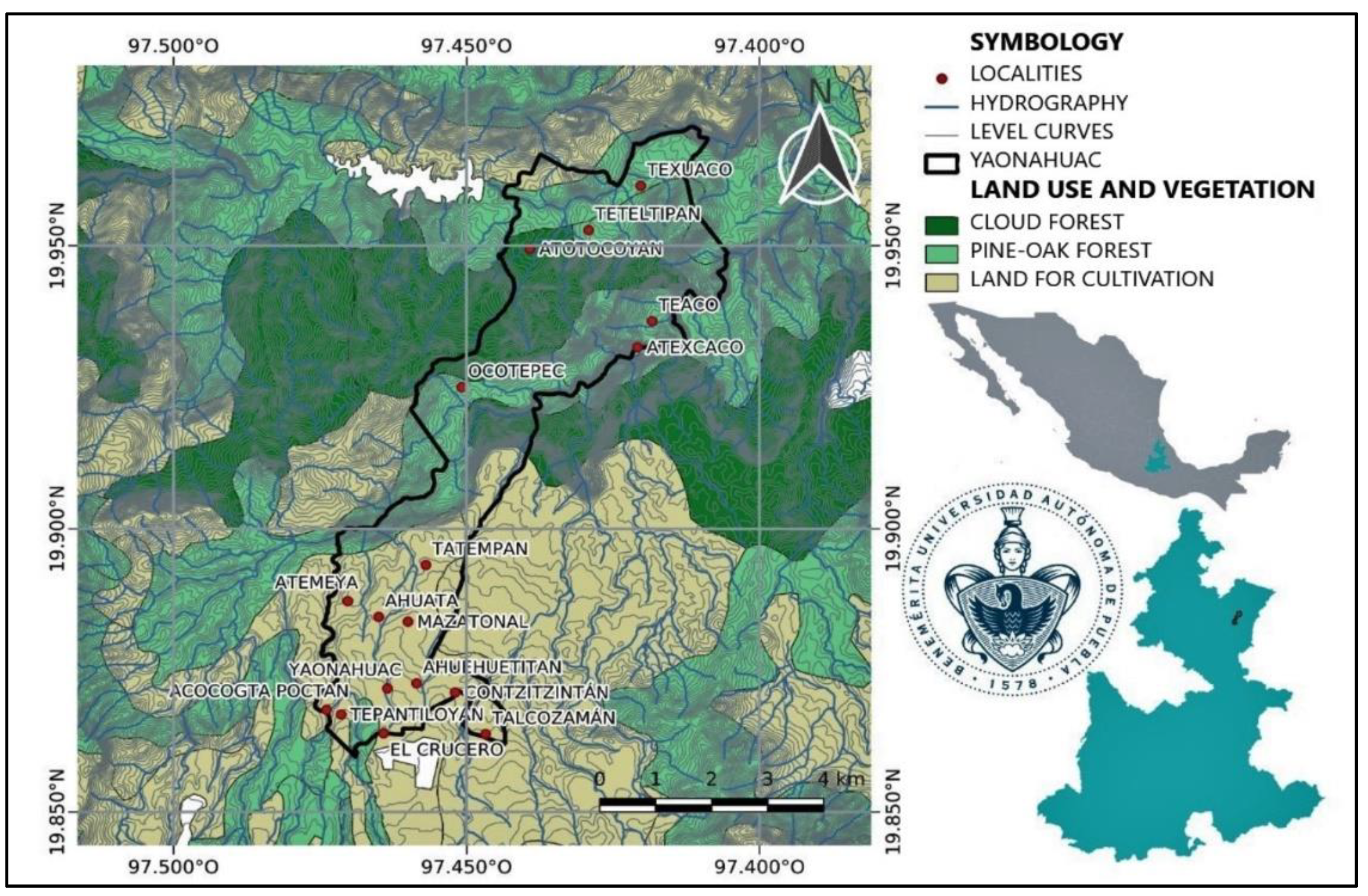
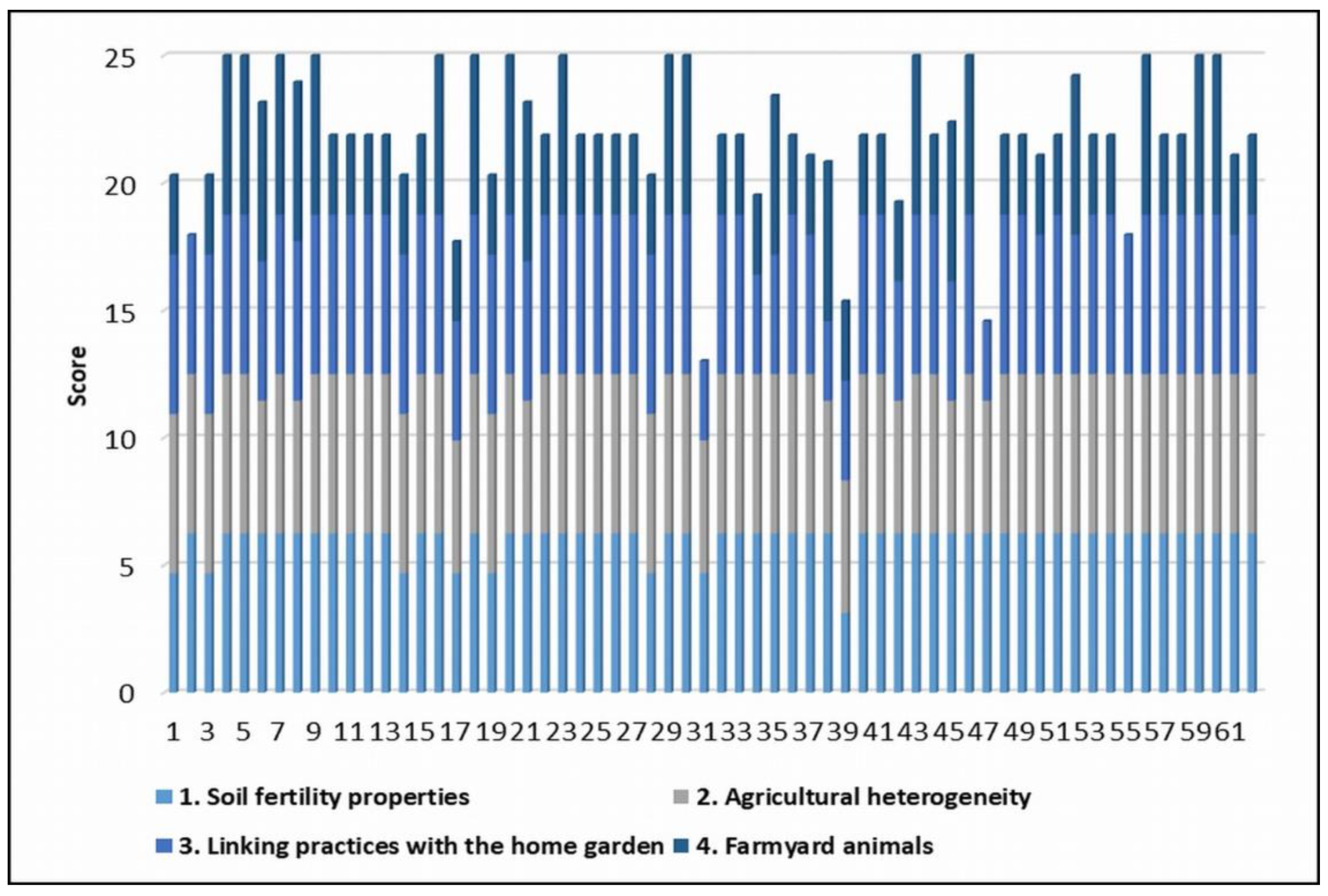

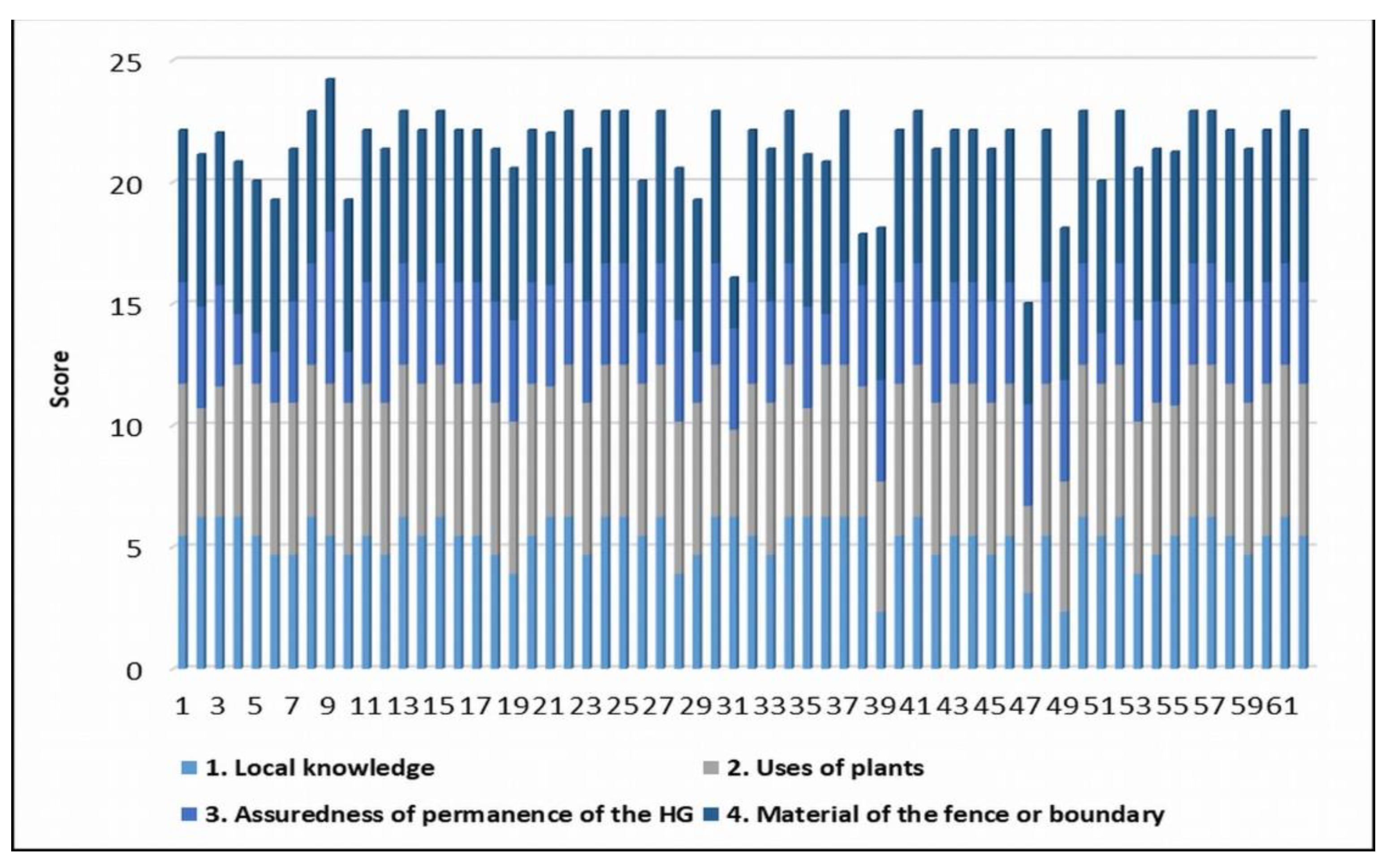

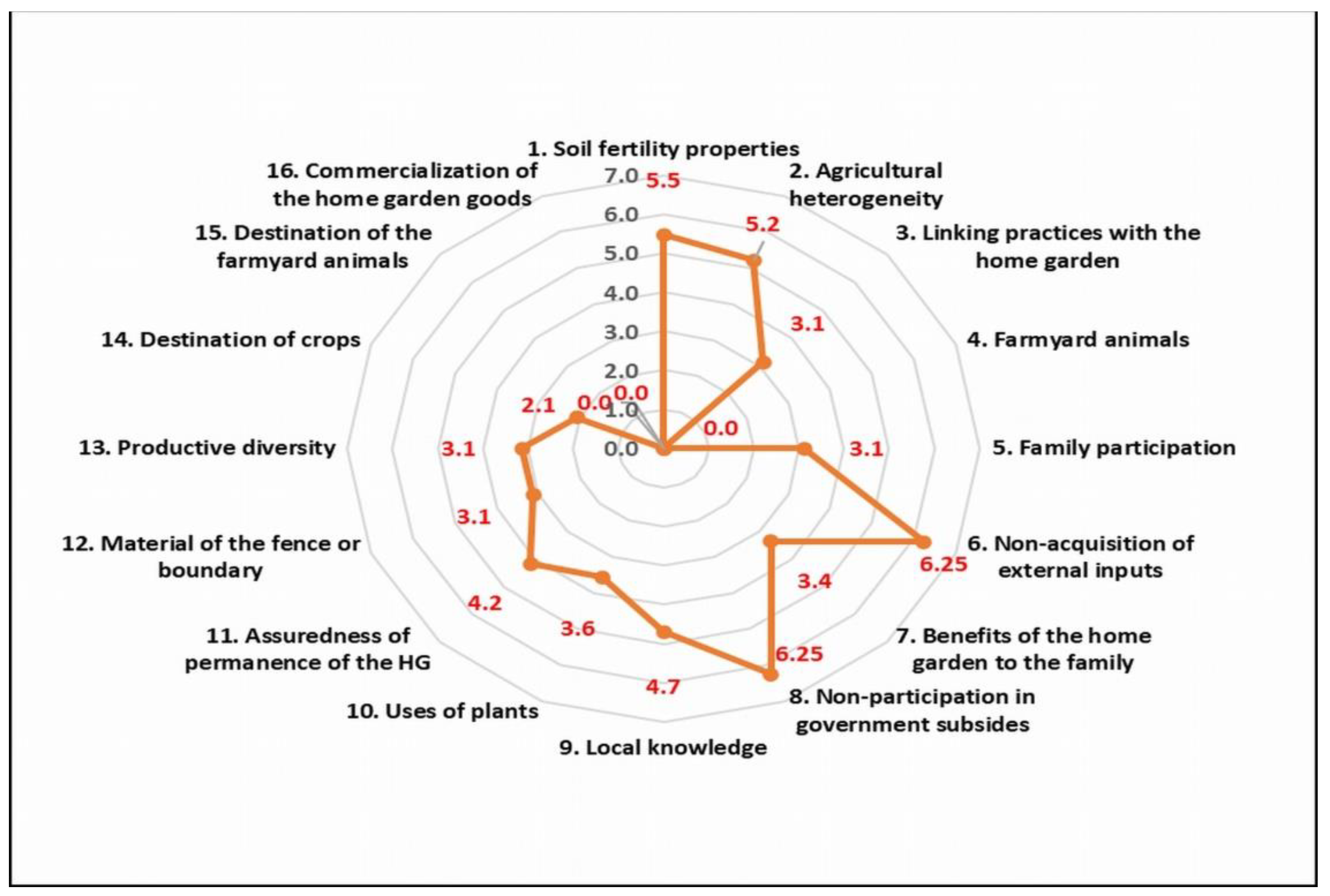
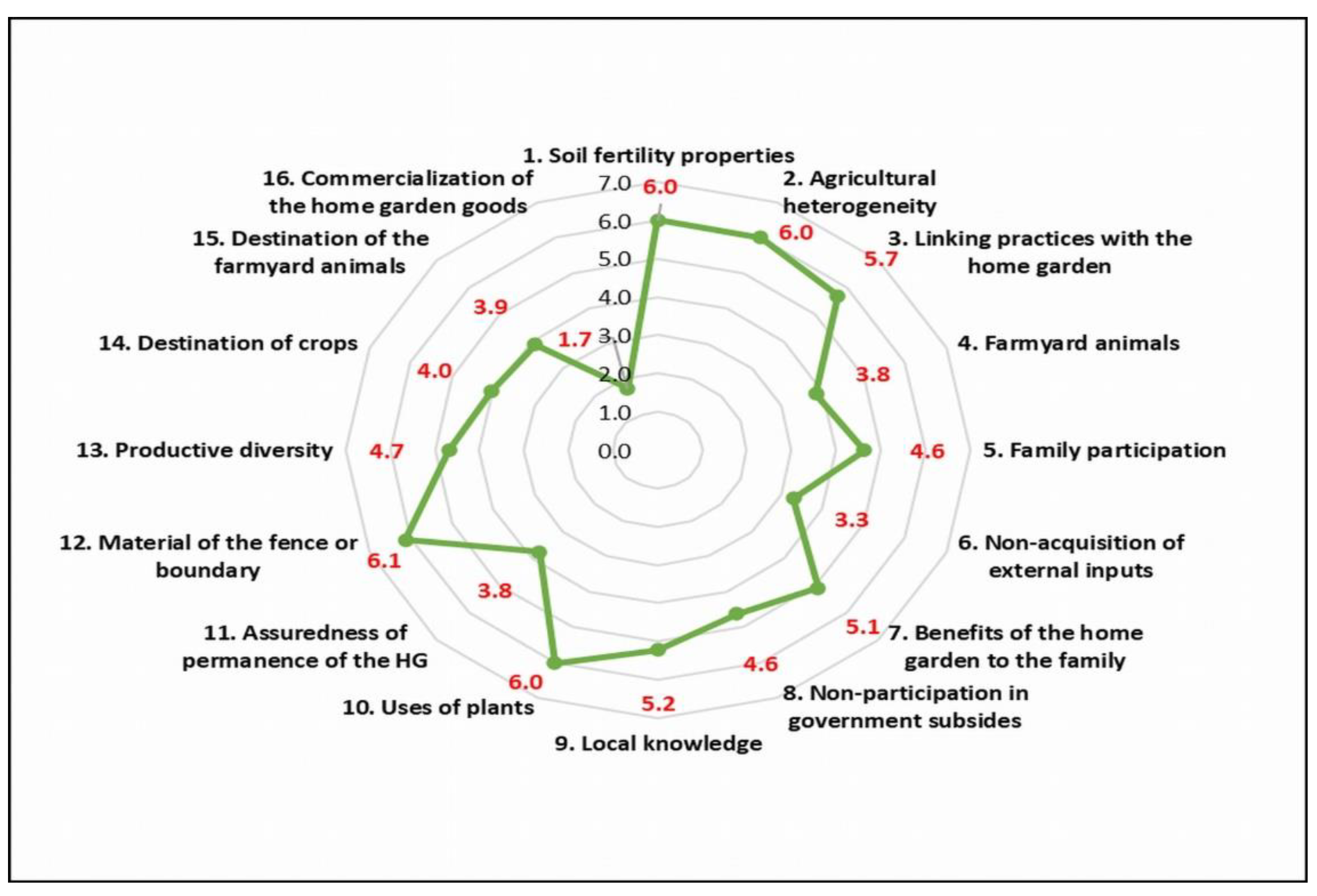
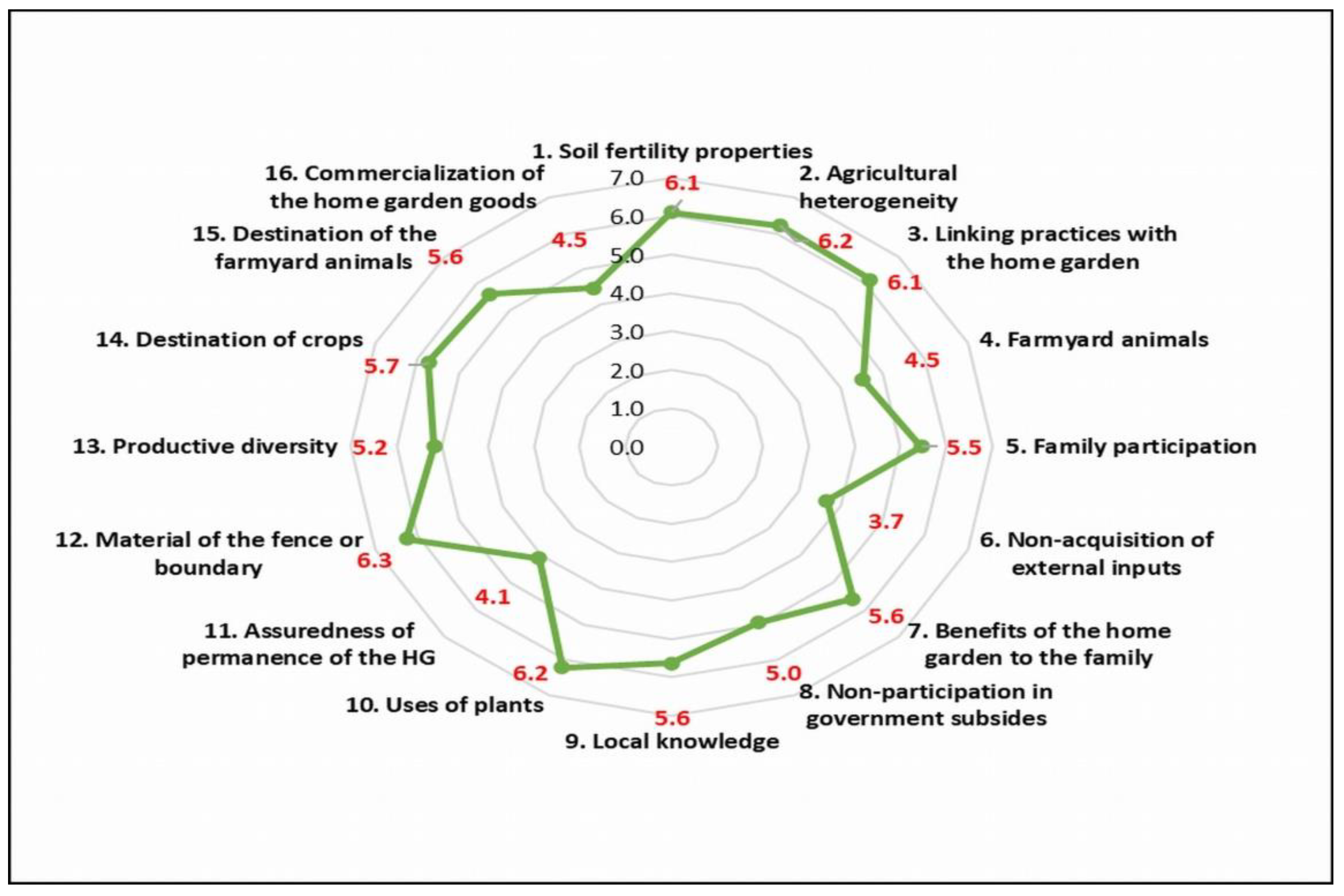
| Dimensions | Principles | References |
|---|---|---|
| Agri-environmental. Relationships between soil, crops, animals, and agricultural activities. | Diversity- Resilience. It is shown when a bio-cultural complex links to a population, whose practices maintain and restore the quality of an agricultural system to ensure food supply. | [6,7,21,30,31,32] |
| Social. Relationships between family, inputs, benefits, and government subsidies. | Self-management-Autonomy. It is the capacity of an agroecosystem to function with its own resources; the use of goods and decision-making responds to the level of organization of the family. | [33,34,35] |
| Bio-cultural. Relationships between knowledge, use of plants, adaptation, and existence of living fences. | Integration. It takes up a set of beliefs and knowledge that families culminate in practices to meet material and spiritual needs (Kosmos-Corpus-Praxis). | [22,23,36,37] |
| Economic. Relationship between productive diversity, destination of crops and animals, and generation of commercialization channels. | Self-sufficiency. Regarding enough diversity of products to meet the needs of consumption and commercialization. | [7,38] |
| Dimension | Weighted Principle * | Weighted Indicator ** | Number of Variables Per Indicator | Weighted Variable *** |
|---|---|---|---|---|
| Agri-environmental | Diversity-Resilience | Soil fertility properties |
| Binary yes/no response 6.25/4 variables = 1.56 points (If Yes = 1.56) (If No = 0) |
| Agricultural heterogeneity |
| Binary yes/no response 6.25/6 variables = 1.04 points (If Yes = 1.04) (If No = 0) | ||
| Linking practices with the home garden |
| Binary yes/no response 6.25/8 variables = 0.78 points (If Yes = 10.78) (If No = 0) | ||
| Farmyard animals |
| Binary yes/no response 6.25/2 variables = 3.12 points (If Yes = 13.12) (If No = 0) | ||
| Social | Self-management-Autonomy | Family participation |
| Relative value (3 variables) (Extended family = 6.25: very much; Nuclear family = 4.16: much and Single-person family = 2.08: low) |
| Non-acquisition of external inputs |
| Binary yes/no response 6.25/8 variables = 0.78 points (If Yes = 0.78) (If No = 0) | ||
| Benefits of the home garden to the family |
| Binary yes/no response 6.25/13 variables = 0.48 points (If Yes = 0.48) (If No = 0) | ||
| Non-participation in government subsidies |
| Relative value (2 variables) (No = 6.25; Yes = 0) | ||
| Bio-cultural | Integration | Local knowledge |
| Binary yes/no response 6.25/8 variables = 0.78 points (If Yes = 0.78) (If No = 0) |
| Uses of plants |
| Binary yes/no response 6.25/7 variables = 0.89 points (If Yes = 10.89) (If No = 0) | ||
| Assuredness of permanence of the home garden |
| Binary yes/no response 6.25/3 variables = 2.08 points (If Yes = 2.08) (If No = 0) | ||
| Material type of the fence or boundary |
| Relative value (3 variables) (Living fence = 6.25: very much; fence of corn cane = 4.26: much and, Artificial fence = 2.08: low) | ||
| Economic | Self-sufficiency | Productive diversity |
| Binary yes/no response 6.25/10 variables = 0.62 points (If Yes = 10.62) (If No = 0) |
| Destination of crops |
| Binary yes/no response 6.25/3 variables = 2.08 points (If Yes = 12.08) (If No = 0) | ||
| Destination of farmyard animals |
| Binary yes/no response 6.25/3 variables = 2.08 points (If Yes = 12.08) (If No = 0) | ||
| Commercialization of the home garden goods |
| Binary yes/no response 6.25/3 variables = 2.08 points (If Yes = 12.08) (If No = 0) |
| Categories | Agroecosystem Description |
|---|---|
| I. Very weak sustainability (<20) | In critical condition due to the minimal contribution of sustainable activities and practices, where no indicator of sustainability is visible. An instrumental value predominates |
| II. Weak sustainability (20.1–40) | Its greater proportion is managed with conventional activities, but some sustainable characteristics appear. An instrumental value predominates. |
| III. Intermediate sustainability (40.1–60) | If sustainable practices are increased it can subsist and stop being vulnerable, but if they decrease it becomes fragile or weak. An anthropocentric perspective predominates. |
| IV. Strong sustainability (60.1–80) | Where there are sustainable practices and is on the way to sustainable reproduction. It is considered that sustainable practices have been adopted in these, diversifying activities that promote sustainability. An anthropocentric perspective predominates. |
| V. Super strong sustainability (80.1–100) | With sustainable activities and practices; with a positive impact on the environment and society. It is ideal for maintaining, replicating, and augmenting. A variety of values, plurality of knowledge and a biocentric perspective predominate. |
| Home Garden | Size (m2) | Diversity-Resilience (25) | Self-Management-Autonomy (25) | Integration (25) | Self-Sufficiency (25) | SITA | Category |
|---|---|---|---|---|---|---|---|
| 1 | 937 | 20.3 | 21.5 | 22.1 | 15.4 | 79.4 | IV |
| 2 | 394 | 18.0 | 18.9 | 21.1 | 12.1 | 70.1 | IV |
| 3 | 186 | 20.3 | 17.8 | 22.0 | 23.1 | 83.3 | V |
| 4 | 426 | 25.0 | 21.4 | 20.8 | 20.2 | 87.4 | V |
| 5 | 643 | 25.0 | 19.4 | 20.1 | 9.8 | 74.2 | IV |
| 6 | 935 | 23.2 | 19.7 | 19.3 | 14.8 | 76.9 | IV |
| 7 | 1292 | 25.0 | 22.0 | 21.4 | 24.4 | 92.7 | V |
| 8 | 339 | 24.0 | 12.6 | 22.9 | 19.0 | 78.4 | IV |
| 9 | 564 | 25.0 | 20.7 | 24.2 | 20.2 | 90.2 | V |
| 10 | 195 | 21.9 | 18.0 | 19.3 | 16.0 | 75.2 | IV |
| 11 | 1040 | 21.9 | 16.2 | 22.1 | 15.4 | 75.7 | IV |
| 12 | 531 | 21.9 | 18.3 | 21.4 | 16.9 | 78.4 | IV |
| 13 | 461 | 21.9 | 21.2 | 22.9 | 24.4 | 90.3 | V |
| 14 | 472 | 20.3 | 20.9 | 22.1 | 24.4 | 87.7 | V |
| 15 | 825 | 21.9 | 17.2 | 22.9 | 24.4 | 86.4 | V |
| 16 | 472 | 25.0 | 14.7 | 22.1 | 24.4 | 86.2 | V |
| 17 | 314 | 17.7 | 18.3 | 22.1 | 14.2 | 72.4 | IV |
| 18 | 513 | 25.0 | 22.7 | 21.4 | 19.6 | 88.6 | V |
| 19 | 532 | 20.3 | 16.7 | 20.6 | 23.8 | 81.3 | V |
| 20 | 664 | 25.0 | 18.0 | 22.1 | 23.1 | 88.3 | V |
| 21 | 356 | 23.2 | 19.3 | 22.0 | 18.3 | 82.8 | V |
| 22 | 748 | 21.9 | 22.7 | 22.9 | 23.8 | 91.2 | V |
| 23 | 205 | 25.0 | 19.1 | 21.4 | 20.2 | 85.7 | V |
| 24 | 273 | 21.9 | 18.5 | 22.9 | 20.2 | 83.5 | V |
| 25 | 416 | 21.9 | 20.9 | 22.9 | 20.2 | 85.9 | V |
| 26 | 652 | 21.9 | 20.9 | 20.1 | 19.0 | 81.8 | V |
| 27 | 133 | 21.9 | 17.3 | 22.9 | 11.9 | 73.9 | IV |
| 28 | 213 | 20.3 | 14.2 | 20.6 | 16.9 | 71.9 | IV |
| 29 | 187 | 25.0 | 14.4 | 19.3 | 18.1 | 76.8 | IV |
| 30 | 241 | 25.0 | 18.6 | 22.9 | 8.5 | 75.0 | IV |
| 31 | 79 | 13.0 | 17.9 | 16.1 | 5.2 | 52.2 | III |
| 32 | 892 | 21.9 | 21.5 | 22.1 | 12.7 | 78.2 | IV |
| 33 | 917 | 21.9 | 22.5 | 21.4 | 16.9 | 82.6 | V |
| 34 | 281 | 19.5 | 14.6 | 22.9 | 14.8 | 71.9 | IV |
| 35 | 414 | 23.4 | 17.8 | 21.1 | 10.6 | 73.0 | IV |
| 36 | 973 | 21.9 | 21.4 | 20.8 | 12.7 | 76.8 | IV |
| 37 | 747 | 21.1 | 24.2 | 22.9 | 23.8 | 92.0 | V |
| 38 | 306 | 20.8 | 17.6 | 17.9 | 14.8 | 71.0 | IV |
| 39 | 182 | 15.4 | 16.8 | 18.1 | 16.3 | 66.5 | IV |
| 40 | 180 | 21.9 | 18.8 | 22.1 | 17.5 | 80.3 | V |
| 41 | 394 | 21.9 | 20.6 | 22.9 | 20.2 | 85.6 | V |
| 42 | 420 | 19.3 | 12.9 | 21.4 | 17.5 | 71.0 | IV |
| 43 | 853 | 25.0 | 15.6 | 22.1 | 24.4 | 87.1 | V |
| 44 | 485 | 21.9 | 19.4 | 22.1 | 19.6 | 82.9 | V |
| 45 | 102 | 22.4 | 17.9 | 21.4 | 14.8 | 76.4 | IV |
| 46 | 1022 | 25.0 | 22.2 | 22.1 | 16.9 | 86.2 | V |
| 47 | 133 | 14.6 | 20.0 | 15.0 | 5.2 | 54.8 | III |
| 48 | 220 | 21.9 | 22.8 | 22.1 | 12.7 | 79.5 | IV |
| 49 | 397 | 21.9 | 16.6 | 18.1 | 13.3 | 69.9 | IV |
| 50 | 605 | 21.1 | 21.3 | 22.9 | 20.2 | 85.6 | V |
| 51 | 645 | 21.9 | 20.1 | 20.1 | 12.7 | 74.7 | IV |
| 52 | 623 | 24.2 | 20.6 | 22.9 | 13.3 | 81.1 | V |
| 53 | 287 | 21.9 | 19.9 | 20.6 | 9.2 | 71.5 | IV |
| 54 | 285 | 21.9 | 20.6 | 21.4 | 13.3 | 77.2 | IV |
| 55 | 429 | 18.0 | 20.7 | 21.2 | 10.0 | 69.9 | IV |
| 56 | 610 | 25.0 | 15.9 | 22.9 | 19.6 | 83.4 | V |
| 57 | 933 | 21.9 | 11.5 | 22.9 | 19.6 | 75.9 | IV |
| 58 | 710 | 21.9 | 14.1 | 22.1 | 17.5 | 75.6 | IV |
| 59 | 762 | 25.0 | 10.7 | 21.4 | 22.3 | 79.4 | IV |
| 60 | 685 | 25.0 | 14.8 | 22.1 | 24.4 | 86.4 | V |
| 61 | 422 | 21.1 | 22.8 | 22.9 | 11.3 | 78.0 | IV |
| 62 | 272 | 21.9 | 20.1 | 22.1 | 18.1 | 82.3 | V |
Publisher’s Note: MDPI stays neutral with regard to jurisdictional claims in published maps and institutional affiliations. |
© 2021 by the authors. Licensee MDPI, Basel, Switzerland. This article is an open access article distributed under the terms and conditions of the Creative Commons Attribution (CC BY) license (https://creativecommons.org/licenses/by/4.0/).
Share and Cite
Palestina-González, M.I.; Carranza-Cerda, I.; López-Reyes, L.; Torres, E.; Silva-Gómez, S.E. Sustainability Assessment of Traditional Agroecosystems in the High Region of Yaonáhuac, Puebla, Mexico. Environments 2021, 8, 40. https://0-doi-org.brum.beds.ac.uk/10.3390/environments8050040
Palestina-González MI, Carranza-Cerda I, López-Reyes L, Torres E, Silva-Gómez SE. Sustainability Assessment of Traditional Agroecosystems in the High Region of Yaonáhuac, Puebla, Mexico. Environments. 2021; 8(5):40. https://0-doi-org.brum.beds.ac.uk/10.3390/environments8050040
Chicago/Turabian StylePalestina-González, María Isabel, Ignacio Carranza-Cerda, Lucía López-Reyes, Eduardo Torres, and Sonia Emilia Silva-Gómez. 2021. "Sustainability Assessment of Traditional Agroecosystems in the High Region of Yaonáhuac, Puebla, Mexico" Environments 8, no. 5: 40. https://0-doi-org.brum.beds.ac.uk/10.3390/environments8050040






